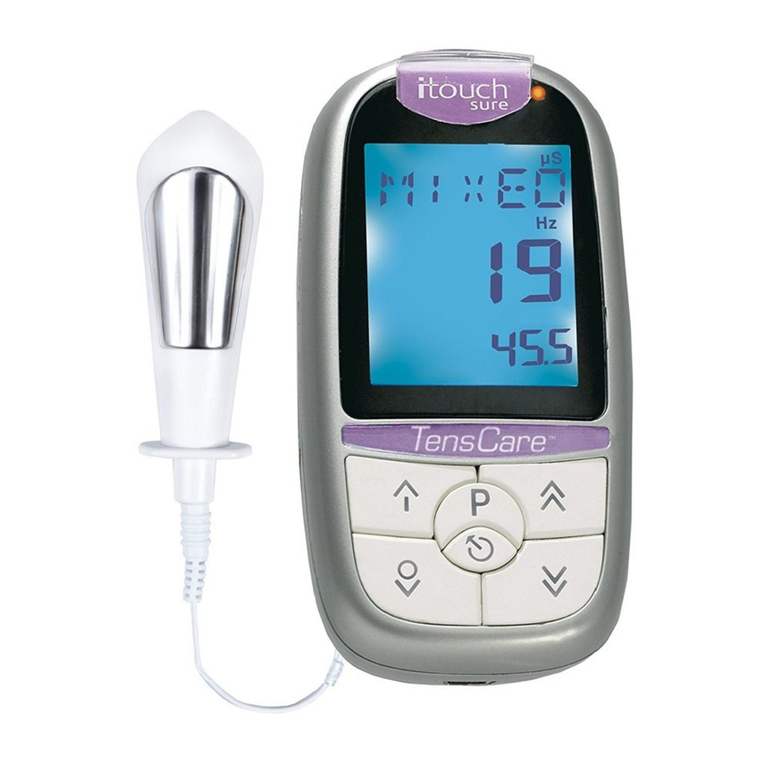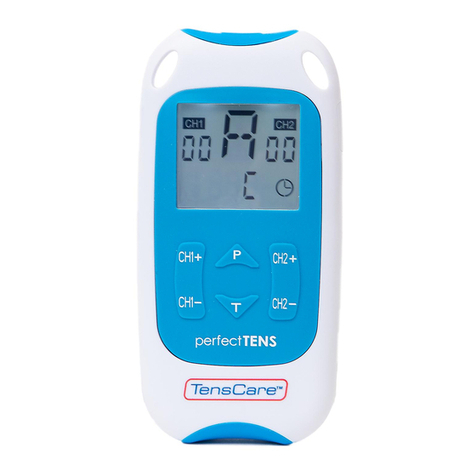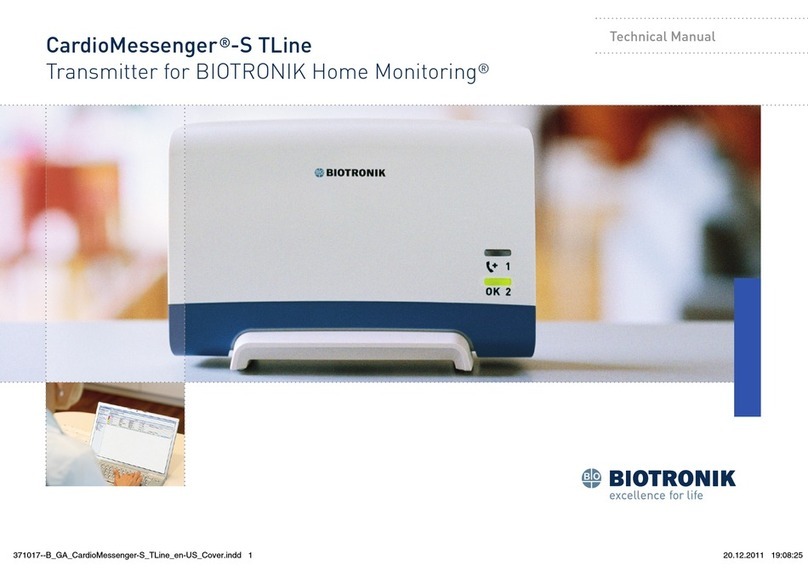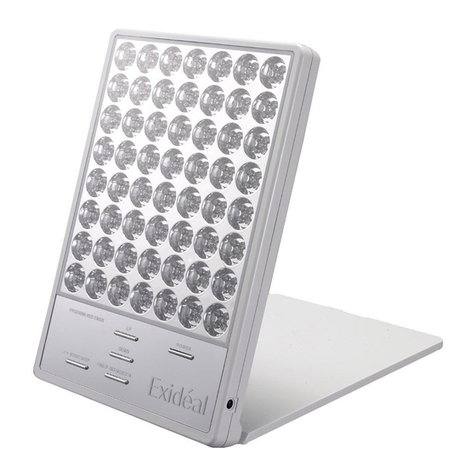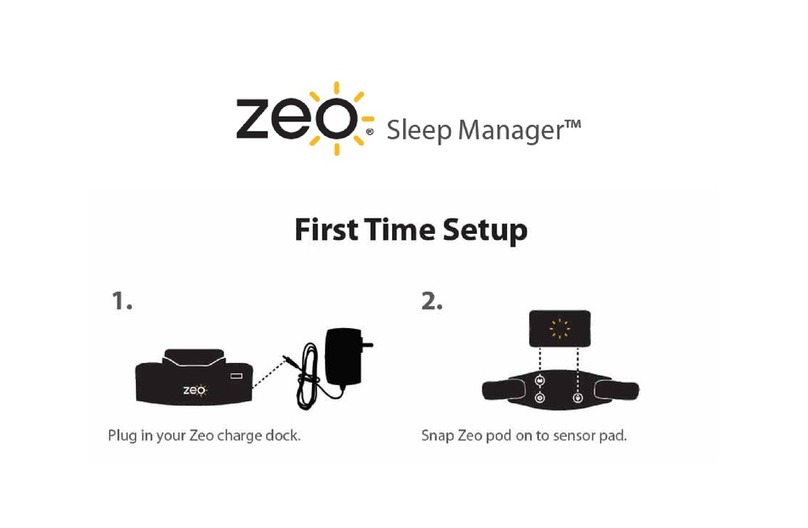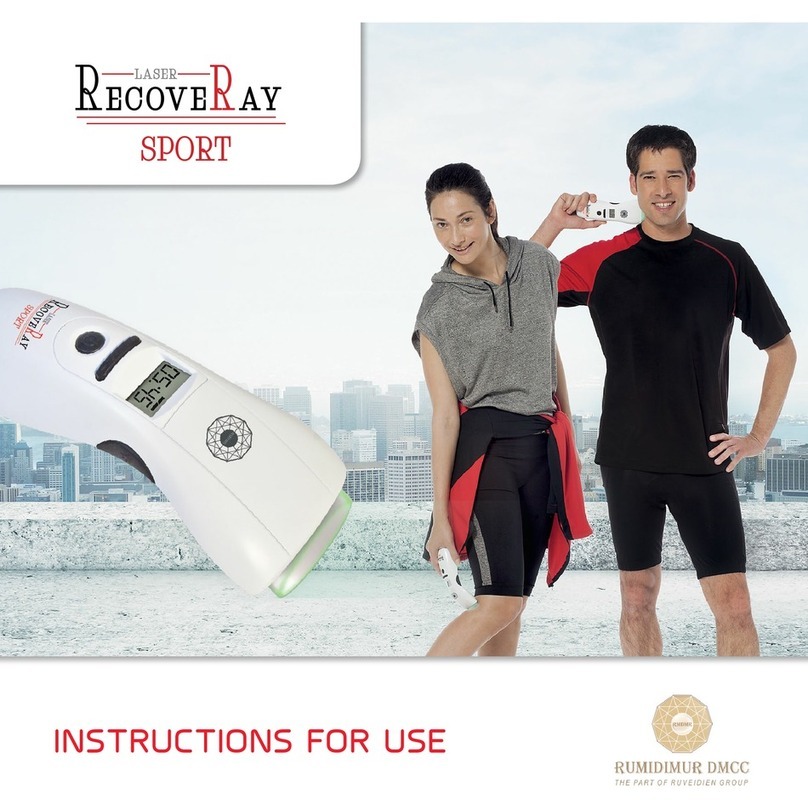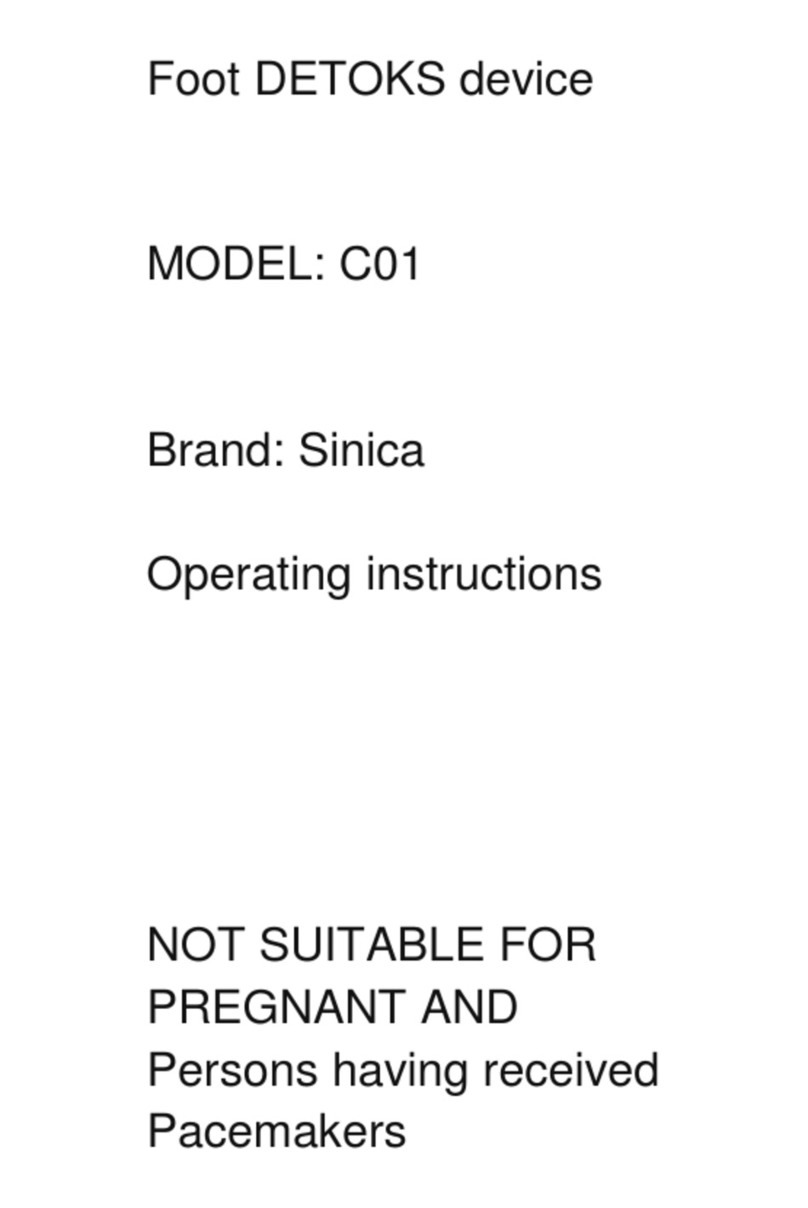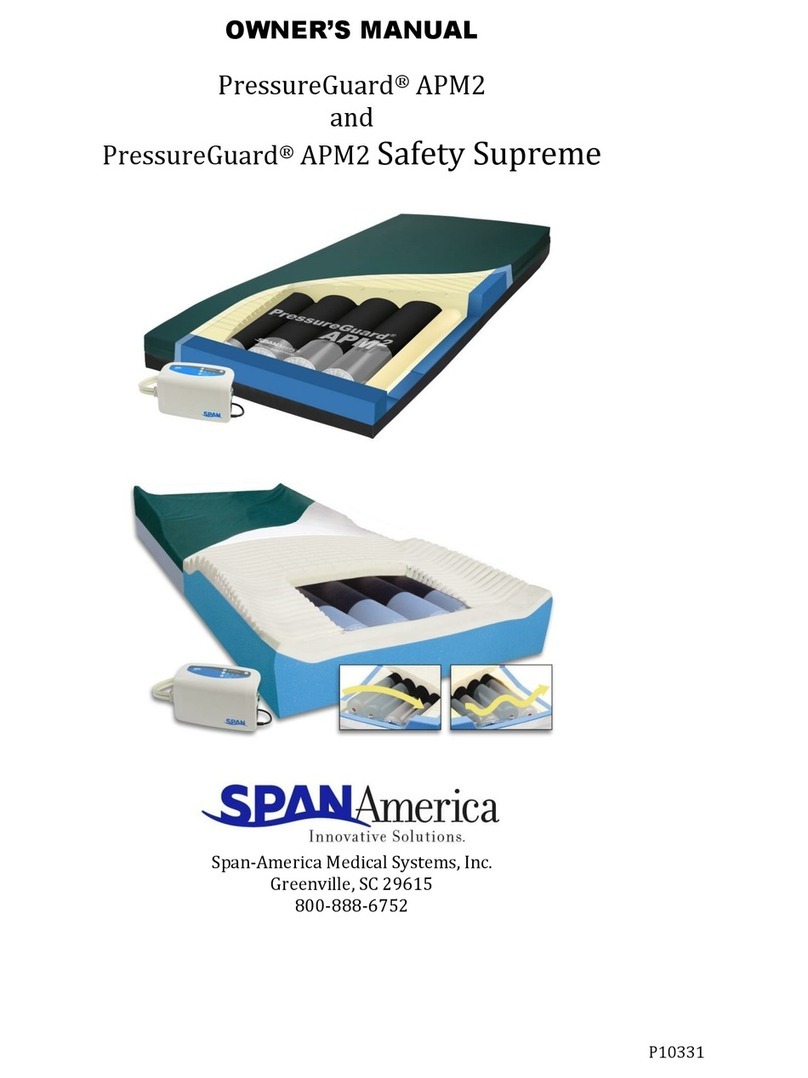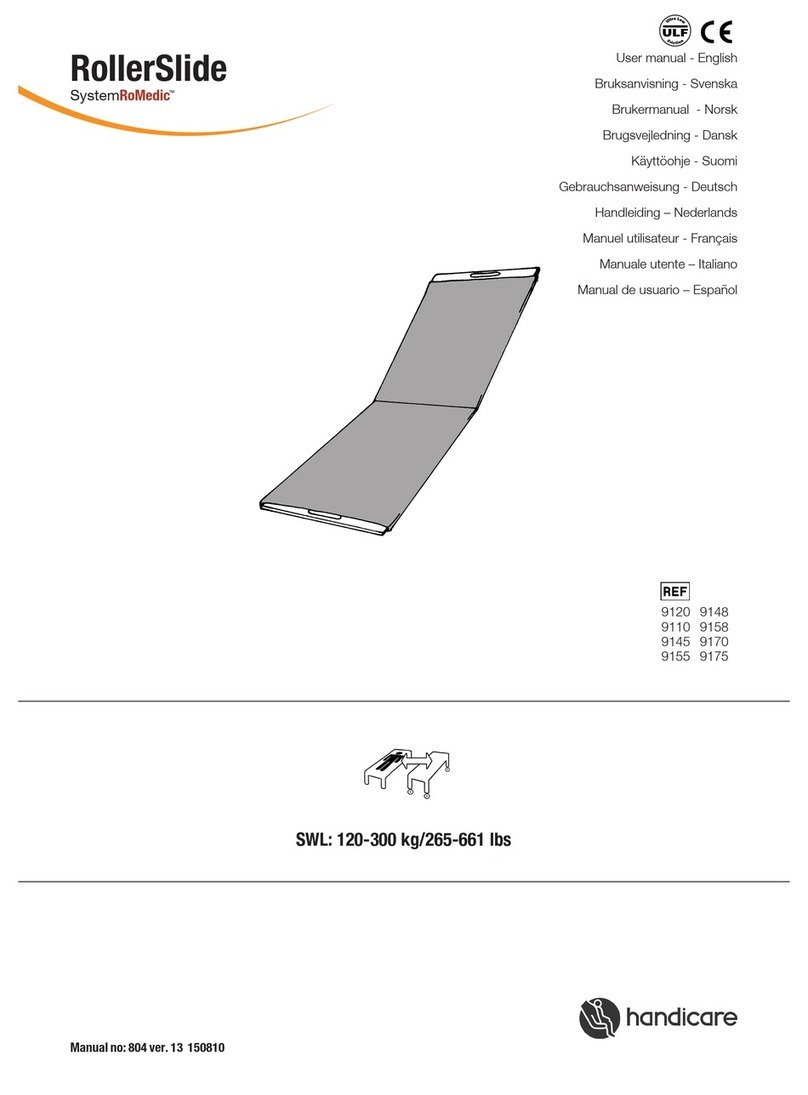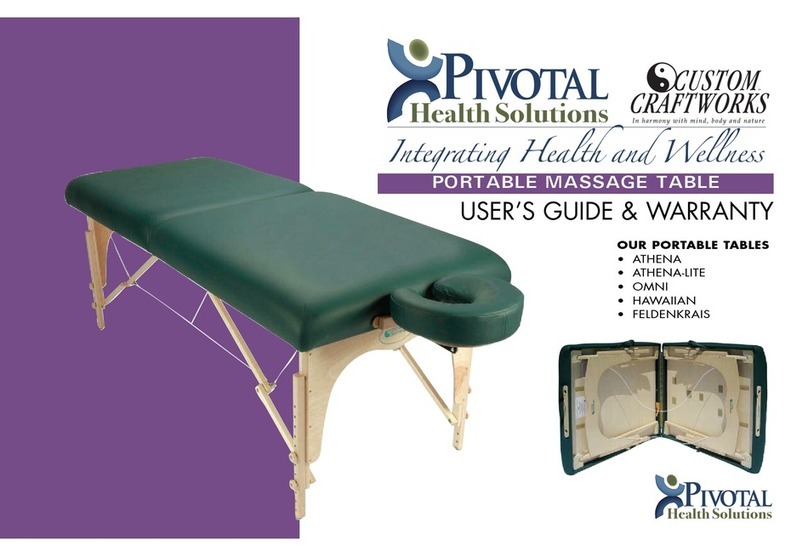TensCare Perfect PFE User manual

0
INSTRUCTIONS FOR USE
READ CAREFULLY BEFORE USE

1
QUICKSTART GUIDE
Connect the unit to the anal
probe
Insert the anal probe until the base
of the flange touches the anus
You can adjust the position of the
flange
Press and hold the ON button
to switch the device on
Regulate the output intensity with
the buttons ▲and ▼
Press and hold the OFF button
to switch the device off
ON
Button P
UP
DOWN
OFF
Select the programme by
pressing the button P
1
2
3
4
5
6

2
Dear Customer,
Thank you for choosing perfect PFE. TensCare stands for high-quality,
thoroughly tested products for the applications in the areas of gentle
electrotherapy, muscle toning, continence management and pain relief
during labour.
Please read these instructions for use carefully and keep them for later
use and observe the information they contain.
Best regards,
Your TensCare Team

3

4
Contents
1. INTRODUCTION.................................................................................................6
2. INTENDED USE..................................................................................................6
3. PERFECT PFE FEATURES................................................................................7
4. PELVIC FLOOR EXERCISES.............................................................................7
4.1. PELVIC FLOOR MUSCLES..........................................................................7
4.2. PERFORMING PELVIC FLOOR EXERCISES .............................................8
5. TYPES OF INCONTINENCE.............................................................................10
6. HOW ‘EMS’ WORKS .........................................................................................11
7. HOW ‘TENS’ WORKS .......................................................................................12
8. CONTRAINDICATIONS, WARNINGS & CAUTIONS ........................................13
9. INFORMATIONABOUT THE PROGRAMME SETTINGS ...............................15
10. PROGRAMMES.............................................................................................16
10.1. PROGRAMME SETTINGS ......................................................................16
10.2. PRESET PROGRAMMES.......................................................................16
11. CONTENT ......................................................................................................17
12. UNIT INFORMATION.....................................................................................18
12.1. CONTROLS & DISPLAY .........................................................................18
12.2. OPERATING INSTRUCTIONS................................................................19
13. SETTING UP AND USING THE PERFECT PFE ...........................................21
13.1. INSTALLATIONOF BATTERIES.............................................................21
13.2. CONNECTING LEAD WIRE....................................................................22
13.3. PREPARING FOR SESSION..................................................................22
13.4. TRAINING SESSION...............................................................................23
13.5. AFTER YOUR TRAINING SESSION.......................................................25
14. CLEANING .....................................................................................................25
15. EMC ...............................................................................................................25
16. DISPOSAL OF WASTE ELECTRICAL AND ELECTRONIC PRODUCTS
(WEEE)....................................................................................................................25
17. ACCESSORIES .............................................................................................26
18. WARRANTY...................................................................................................27
19. TROUBLESHOOTING ...................................................................................28
20. GENERAL SPECIFICATION..........................................................................30
NOTES.....................................................................................................................33

5
SYMBOLS USED
Attention! Please follow the instructions in the user’s instructions for use.
TYPE BF EQUIPMENT: Equipment providing a degree of protection against
electric shock, with isolated applied part. Indicates that this device has conductive
contact with the end user.
This symbol on the unit means “Refer to instructions for use”.
Temperature Limitation: indicates the temperature limits to which the medical
device can be safely exposed.
Lot Number: indicates the manufacturer’s batch code so that the batch or lot can
be identified.
Humidity Limitation: indicates the humidity limits to which the medical device can
be safely exposed.
Serial Number: indicates the manufacturer’s serial number so that a specific
medical device can be identified.
Do not dispose in household waste.
Catalogue Number: indicates the manufacturer’s catalogue number so that the
device can be identified.
This medical device is not water resistant and should be protected from liquids.
Atmospheric Pressure: indicates the atmospheric limits to which the medicaldevice
can be safely exposed.
Date of Manufacture: indicates the date which the medical device was
manufactured. This is included within the serial number found on the device
(usually in the battery compartment), either as “E/Year/Number” (YY/123456) or
“E/Month/Year/Number” (MM/YY/123456).
This medical device is indicated for home use.
The first number 2: Protected against access to hazardous parts with a finger,
and the jointed test finger of 12 mm ø, 80 mm length, shall have adequate
clearance from hazardous parts, and protected against solid foreign objects of 12.5
mm ø and greater.
The second number 2: Protected against vertically falling water drops when
enclosure is tilted up to 15˚. Vertically falling drops shall have no harmful effects
when the enclosure is tilted at any angle up to 15˚ on either side of the vertical.
LOT
S/N
REF
IP22

6
1. INTRODUCTION
Device Description & Principles of
Design
Bladder leakage and incontinence are
common problems for both women and
men, affecting their long-ter m health.
Exercising the pelvic floor muscles is
recognised as the way of preventing
and treating symptoms of incontinence
and pelvic floor weakness.
The perfect PFE is a powered muscle
stimulator used for strengthening the
pelvic floor muscles.
It sends a gentle stimulation (similar to
your natural nerve impulses) direct to
your pelvic floor muscles through an
anal probe with stainless steel
electrodes or with optional electrode
pads. These signals make your pelvic
floor muscles contract. If you have
forgotten how to contract them, are
having trouble getting muscle
response, or simply want to bring back
the condition of your pelvic floor
muscles, the perfect PFE can work
themfor you to build up their strength
and help you to develop your own
muscle control. It perfectly
complements pelvic floor exercises.
The perfect PFE is very easy to use,
with four clearly labelled preset training
programme s, a fifth programme for
chronic pelvic pain and a si mple push
button control.
The perfect PFE provides relief from
conditions such as:
•Urinary and faecal incontinence:
including stress, urge and mixed
types as well as post prostatectomy
urinary incontinence in men.
Additionally, it may help improve
sexual intimacy by toning the pelvic
floor muscles.
•Chronic prostatitis/chronic pelvic
pain syndrome: unexplained
chronic pelvic pain associated with
irritative voiding symptoms and/or
pain located in the groin, genitalia, or
perineum in the absence of pyuria
and bacteriuria.
•Treatment of erectile dysfunction
in men and improvement of pelvic
strength.
Also, can be used for non-medical
purposes to:
•maintain a healthy bowel movement
•achieve a more satisfying erection
•improve rectal sensation for
enhanced pleasure
•improve pelvic strength
2. INTENDED USE
Perfect PFE is a medical
device designed to be used in
the home healthcare
environment to treat symptoms of
urinary and/or faecal incontinence and
to treat erectile dysfunction and is
suitable for use by all who can control
the device and understand the
instructions.
Perfect PFE may help to relieve
symptoms of chronic prostatitis/chronic
pelvic pain.
Do not use the device for any purpose
other than this intended use.
Warning: Not suitablefor use in
children without medical
supervision.

7
3. PERFECT PFE
FEATURES
•Single Channel
Single channel unit to treat symptoms
of urinary and faecal incontinence via
an anal probe with adjustable depth.
•Comfortable Stimulation
Gentle stimulation with fine tune
adjustment settings for different levels
of intensity, 1 mA per step.
•5 Preset Programmes
EMS programmes including STRES,
URGE, MIXED and TONE aftercare;
and additional TENS programme
providing relief fromprostatitis pain and
pelvic pain.
•Memory
Features 3 functions: programme
retention (automatically starts in the last
programme used), number of uses and
time of usage.
•Treatment Timer
Unit def aults to 20 minutes’ tr eat ment to
ensure the pelvic floor muscles are not
over-worked. The user can manually
reset this (Continuous, 10, 20, 30, 45,
60 or 90 mins).
•Open Circuit Detection
Automatically resets the strength to
zero and flashes ‘LEADS’ if the
connection comes loose.
•Automatic Keypad Lock
Automatic keypad lock prevents any
accidental changes in settings.
•Large LCD Screen
Clearly shows the operation of the unit
and the programme and intensity being
used.
4. PELVIC FLOOR
EXERCISES
4.1. PELVIC FLOOR
MUSCLES
The “FLOOR” of your pelvis is made up
of layers of muscles that support the
bowel, bladder, urethra and uterus.
These muscles are like a hammock, or
the bottom and sides of a bowl, in
shape. They run fromthe pubic bone in
thefront to the end of the spinal column
(or tail bone) in the back.
The pelvic floor muscles:
•Assist in supporting the abdominal
and pelvic organs.
•Work with the abdominal and back
muscles to stabilise and support the
spine.
Pelvic floor muscles are also important
for sexual function in both men and
women:
•In men, it is important for erectile
function and ejaculation.
However pelvic floor muscles may
become weak. If your pelvic floor
muscles become stretched or
weakened, your pelvic organs may no
longer be fully supported and you may
lose control of your bladder or bowel
movements.

8
Pelvic floor muscles can be made
weaker by:
•Certain treatments for prostate
cancer (surgery, radical
prostatectomy or transurethral
resection of the prostate TURP);
•Constipation;
•Being overweight;
•Heavy lifting;
•Coughing that goes on for a long
time (such as smoker's cough,
bronchitis or asthma); or
•Not being fit.
Common signs that can indicate a
pelvic floor probleminclude:
•Accidentally leaking urine when you
exercise, laugh, cough or sneeze
•Needing to get to the toilet in a hurry
or not making it there in time
•Constantly needing togo to the toilet
•Finding it difficult to empty the
bladder or bowel
•Accidentally losing control of the
bladder or bowel
•Accidentally passing wind
•Pain in your pelvic area
•Painful sex, or
•A prolapse
In men, this may be felt as a bulge in
the rectum or a feeling of needing to
use the bowel but not actually needing
to go.
Like other muscles in your body, the
pelvic floor can be strengthened with
regular exercise. Building pelvic floor
strength enables the muscles to better
support your pelvic organs, improves
your bladder and bowel control and can
stop accidental urine, faeces or wind
leakage.
Men with stress incontinence –that is,
men having bladder leakage when they
cough, sneeze or are active –will find
pelvic floor muscles training can help in
getting over this problem.
Pelvic floor muscles training may also
be of use for men who have an urgent
need to pass urine more often (called
urge incontinence).
Men who have problems with bowel
control might find that training their
pelvic floor can help the muscle that
closes the back passage. This muscle
is one of the pelvic floor muscles.
It can alsoreduce your risk of prolapse,
improve your recovery from urology
surgery, and increase your sexual
pleasure. A continence therapist can
help you learn how to exercise your
pelvic floor.
Doing just a few pelvic floor exercises
every day will help to treat bladder
weakness or prolapse symptoms, and
will help to prevent problems later on.
4.2. PERFORMING PELVIC
FLOOR EXERCISES
It isrecommended tomake Pelvic Floor
Exercises (sometimes called Kegel
Exercises) part of your daily life.
1) Kegel exercises can be done at any
time and arevery discreet so you can
do them almost anywhere; lying in
bed, sitting at the computer or
waiting for a bus. It is a good idea to
try and develop a routine which you
can repeat each day.
2) First, it isimportant tofind your pelvic
floor muscles andfeel themworking.
So here is a technique which might
help:
Try to stop the flow of urine during
urination. If you are successful, then
you know you are exercising the
correct muscles.

9
Note: This technique is just to
help you confir m that you are
using the correct muscles. It is
important to have an empty bladder
bef ore starting the exercises.
Pelvic floor exercises can be done
anywhere and anytime. You can
perfor m them standing, squatting or
lying down but at first you may find it
easier to do the exercises sitting down:
•Sit on a chair, toilet seat or toilet lid.
•Make sure that your feet are flat on
the floor and your legs are slightly
apart.
•Lean forwards, resting your elbows
on your knees.
There aretwo types of exercises –slow
twitch andfast twitch. It is important that
you do the slow twitch first and then the
fast twitch each time you exercise your
pelvic floor muscles.
To perform the slow twitch
exercises:
1) Close and draw up the muscles
around back passage, as if you are
trying to stop passing wind. Make sure
that you do not contract (tighten) your
buttock muscles while you do this.
2) Now close and draw up the muscles
around your urethra, as though you are
trying to stop theflow of urine.
3) Try not to hold your breath, breathe
nor mally. Pull upwards and count how
long you can hold the squeeze. If you
can holdfor a count of 10, then relax for
a count of 10.
4) Repeat this until you feel tired.
5) Over time you should be able to
increase the length of time you can hold
for.
To perform the fast twitch exercises:
1) Pull up the pelvic floor muscles as
bef ore.
2) Hold for one second and then relax.
3) Repeat until your muscles feel tired.
Pelvic floor muscles tire easily and you
may notice that it takes a lot of
concentration to begin with to do these
exercises correctly. If you find that the
muscles ‘let go’ too quickly and that you
cannot hold for long, just hold themfor
as long as you can. If you can only hold
the contraction for a count of three, then
every time you do your exercises,
contract the muscles for a count of
three. Gradually try to work up to four,
then five and so on. Once you feel
confident in doing the exercises try
doing themin other positions, such as
standing or squatting.
Remember to tighten your pelvic floor
muscles during and after any activity
that makes you leak –like rising froma
chair or coughing –so that tightening
becomes an automatic reaction.
While perfor ming the exercises, it is
important not to:
●Squeeze your buttocks together
●Bring your knees together
●Hold your breath
●Lift your shoulders, eyebrows or toes
upwards
Do not worry if youfindholding for three
seconds difficult at first. Just squeeze
for as long as youfeel comf ortable to do
so. The more exercise you do, the
stronger the muscles will become and
the longer you will be able to squeeze.

10
Note: It is important to aimfor
quality contractions, not
quantity, so a few good hard
squeezes are better than a series of
weak ones.
Using your perfect PFE pelvic floor
stimulator in conjunction with Kegel
exercises will give you a better
understanding of how they work and
how to get the greatest benefit from
them.
5. TYPES OF
INCONTINENCE
There are three types of incontinence:
Stress, Urge, and Mixed.
Stress Incontinence
If you leak urine when you cough,
sneeze, laugh, strain or make sudden
movements, this is called Stress
Incontinence.
It is particularly common in men after
radical prostatectomy and occurs when
the bladder neck and the other
mechanisms that act to hold urine in the
bladder are not working properly. The
most common cause is a weak pelvic
floor.
Urge Incontinence
Describes an overactive bladder. A
person may experience a strong and
sudden urge to go to the toilet but are
not always able to hold on, or must go
so frequently that it becomes
inconvenient.
Mixed Incontinence
Is a combination of both Stress and
Urge Incontinence.
Faecal Incontinence
Faecal incontinence can be theresult of
weakened or poorly functioning anal
sphincter muscles or damage to the
nerves controlling them. The purpose is
to re-educate the anal sphincter and
other muscles of the pelvic floor to
contract. The treatments aim to
progress towards graduated active
exercises, in order to improve pelvic
floor muscle strength and endurance
and to regain function.
You may benefit fromthe perfect PFE
if you either have no active anal
sphincter contraction, or a weak or
poorly sustained contraction. Use the
STRES or TONE programmes.
Intensity should be as strong as
possible without being painful. When
possible, try to contract the muscles at
the same time as the perfect PFE.
Post Prostatectomy Urinary
Incontinence
Electrical stimulation has been found to
help urinary incontinence in men after
radical prostatectomy in some trials.
Choose the programme depending on
the type of incontinence you are
suffering from and increase the
intensity to the highest tolerable.
Chronic prostatitis/chronic pelvic
pain syndrome: unexplained chronic
pelvic pain associated with irritative
voiding symptoms and/or pain located
in the groin, genitalia, or perineum in
the absence of pyuria and bacteriuria.
Low frequency stimulation stimulates
therelease of Endorphins –your body’s
natural pain relief mechanism –to
reduce pain without side effects.

11
6. HOW ‘EMS’ WORKS
E.M.S. stands for Electrical Muscle
Stimulation and has successf ully been
used in medical rehabilitation and
training in competitive sports. EMS
produces intensive and effective
muscular contraction.
In rehabilitation, EMS is a well-
established method for treatment of a
broad field of musculoskeletal
diagnoses as well as pelvic floor
weakness. Electrical stimulation of an
intact peripheral nervous system may
create motor responses in patients with
impaired or lost ability for voluntary
muscle activity.
EMS is a complement to other physical
therapy and should always be
combined with active training such as
Kegel exercises (see section 4.2.).
Advantages of EMS
Use of EMS may lead tofaster progress
in the patient’s tr eat ment pr ogra mme.
The method is simple and appropriate
for treatment in the clinical setting as
well asfor self-treatment at home.
How EMS Works
Electrical Muscle Stimulators can play a
vital role in educating women and men
about their pelvic floor and the
sensation they should feel when doing
pelvic floor exercises. Electrical Pelvic
Floor Exercisers (PFE) offer a non-
invasive method of producing
contraction of muscles via a gentle
stimulation to the pelvic floor through a
discreet probe or electrode pads when
they are placed close to the nerve that
controls the pelvic floor muscles. This
current then passes into the nerve
fibres controlling that part of the muscle
stimulating it to contract. So, electrical
stimulation (EMS) artificially activates a
musclefor you enabling you to develop
your own muscle control. These
contractions exercise the muscles and,
as with any kind of exercise if
perfor med regularly, build strength and
tone.
In urge incontinence, pelvic floor
exercisers work in a slightly different
way. The electrical stimulation is
designed to soothe your bladder
muscles rather than exercise your
pelvic floor. Perfect PFE uses a
gentler, low frequency setting which
promotes release of endorphins and
reduces involuntary contractions of the
bladder (detrusor) muscle.
Different frequencies have different
effects; low frequencies (1-10 Hz)
coupled with long impulse times, for
example, have a purifying and relaxing
effect through individual contractions,
whereby the circulation in the treated
muscle is simultaneously improved and
removal of metabolic end products is
supported (lymphatic drainage). The
oxygen supply to the muscle is
improved.
In contrast, by means of a rapid
succession of contractions (fibrillation),
mediumfrequencies (20-50 Hz) can put
a high level of strain on the muscle, thus
promoting the muscular structure.
Each preset programme has a specific
frequency and pulse width that will offer
the best results for the type of
incontinence treated.

12
7. HOW ‘TENS’WORKS
T.E.N.S. stands for Transcutaneous
Electrical Nerve Stimulation. T.E.N.S.
sti mulates your body’s own natural
defences against pain, namely the
release of endorphins. TENS is totally
safeand has been used successfully by
thousands of pain sufferers.
TENS sends a gentle stimulation
through the skin which works in
TWO ways:
Pain Gate
It stimulates the
sensory nerves,
which carry touch
and temperature
signals. These
nerves go to the
same connections in the spine as the
nerves carrying pain. A strong sensory
signal will block the pain signal
travelling up the spine to the brain. This
is known as closing the “Pain Gate” and
takes effect quite quickly after the unit
is switched on. When the gate is open,
pain messages get through to the brain
and we feel pain. When the gate is
closed, these pain messages are
blocked and we do not feel pain.
Evidence suggests that TENS produce
pain r elief in a si milar way to ‘r ubbing
the pain better ’. The pain gate can be
closed by activation of
mechanor eceptor s through ‘r ubbing the
skin’.
Scientifically, the pain gate works by
release of chemical in the synapse at
spinal level that inhibits transmission of
pain signal.
Endorphin Release
At low frequency
settings, and slightly
stronger outputs,
TENS drives the
motor nerves to
produce a small
repetitive muscle contraction. This is
seen by the brain as exercise, and this
promotes the release of endorphins -
your body’s own natural pain killer . The
relief builds up and nor mally takes
about 40 minutes to reach a maximum
level which can last for hours after the
machine is switched off.
By using TENS, you can expect to
achieve a significant reduction in pain -
if not complete relief frompain.
•TENS is effectivefor painfroma very
wide range of causes.
•TENS machines can be used to help
reduce pain from problems in
muscles, joints and nerves.
•It can be also used for people with
musculoskeletal pain such as long-
ter m(chronic) back pain or knee joint
arthritis. They are also often used for
pain relief in the early stages of
labour (see perfect mamaTENS),
particularly whilst a pregnant woman
remains at home.
•Other uses include migraine
headaches, period pain and
endometriosis (see Ova+), cystitis,
sports injuries, Raynaud disease,
fibromyalgia and neuralgia, plantar
fasciitis, post-operative pain and
someti mes non-painful conditions
such as tiredness, insomnia, travel
sickness, tinnitus or dementia.
•You can use low frequency (<10 Hz)
programmes on acupuncture points,

13
to achieve similar effects to
acupuncture.
•With neurogenic pain (caused by
inflamed nerves) such as shingles
and neuralgia, TENS may start by
increasing the pain. We recommend
that you only use TENS for these
conditions under medical
supervision.
•You can safely use TENS as long as
it gives you pain relief. The effect
may wear off after a few hours (this
is called “acco mmod ation”). If this
happens, take a break of an hour or
so before trying again. If you use
settings that cause muscle
movement for more than 40 minutes,
you may experience aching muscles
a few hours later.
8. CONTRAINDICATIONS,
WARNINGS &
CAUTIONS
In this manual:
A Warning is used when failure
to follow the instructions may
result in serious injury or death.
A Caution is used when failure
to follow the instructions may
result in a minor or moderate injury, or
damage to the device or other property.
Notes are used to provide
clarification or
recommendation.
CONTRAINDICATIONS:
•Do NOT use with optional electrode
pads if you have a pacemaker (or if
you have a heart rhythm problem) or
with any electronic medical devices.
Using this unit with electronic
medical devices may cause
erroneous operation of the device.
Stimulation in the direct vicinity of an
implanted device may affect some
models. Stimulation on the front of
the neck can affect your heart rate.
Very strong stimulation across the
chest may cause an extra heartbeat.
•Do NOT use in the first 6 weeks
following a surgery in the area being
treated. Stimulation may disrupt the
healing process.
•Do NOT use if you have symptoms
of active urinary tract infection or
localized lesions. Introducing the
probe may irritate sensitive tissue.
•Do NOT use if you have poor
sensation in the pelvic region. You
may not be able to control the
intensity of stimulation safely.
WARNINGS:
Do NOT use if you are unable
to properly insert the probe. If
you have a severe prolapse, or if any
discomf ort occurs when inserting the
probe, consult your healthcare
professional before use.
Do NOT use when driving,
operating machinery, or similar
actions needing muscular
control. Loose electrode pads,
damaged leads, or sudden changes in
contact may cause brief involuntary
muscle movements.
Do NOT use to mask or relieve
undiagnosed pain. This may
delay diagnosis of a progressive
condition.
Do NOT use if you have, in the
area being treated: active or
suspected cancer or undiagnosed pain

14
with a history of cancer. Stimulation
directly through a confirmed or
suspected malignancy should be
avoided as it may stimulate growth and
promote spread of cancer cells.
CAUTIONS:
Caution should be used if you
have suspected or diagnosed
epilepsy as electrical stimulation may
affect seizure threshold.
Caution should be observed
when using the device at the
same time as being connected to
monitoring equipment with body
worn electrode pads. It may interfere
with the signals being monitored.
Caution: Simultaneous
connection to high frequency
surgical equipment may result in burns
and damage to the stimulator.
Caution: Strong
electromagnetic fields (electro-
surgery/ microwave cookers/ mobile
phones) may affect the correct
operation of this unit. If it appears to
behave unusually, move it away from
these devices.
Caution Do not per mit use by
persons unable to understand
the instructions or persons with
cognitive disabilities, i.e.; Alzhei mer ’s
disease or dementia.
Caution: Insertion of the anal
electrode makes it unsuitable
for use in children without clinical
supervision
Caution: Keep away from
children under 5 years of age.
Long cord - risk of strangulation in
infants.
Caution should be observed
when using the perfect PFE at
high strength settings.
Prolonged use at high settings may
cause muscle injury or tissue
inflammation.
Note: No serious or long ter m
adverse effects have been
reported. Mild adverse
reactions are very rarely reported, but
these have included muscular pain and
cramps, irritation and bleeding, mild or
short ter murge or faecal incontinence,
and tingling sensation in legs. If you
experience any of these, stop use.
When symptoms have gone, try
resuming at a lower intensity setting.
PROBE CAUTIONS:
Caution: The perfect PFE
anal probe is intended for
single patient use only. Do not share
your perfect PFE probe with anyone
else. Improper treatment or cross-
infection may occur.
Caution: It is important that the
anal probe is cleaned after
each use. Ineffective cleaning may lead
to irritation or infection.
Caution: Never insert or
remove anal probe unless the
control unit is powered OFF as insertion
or removal when stimulation is active
may cause discomfort or tissue
irritation.
Caution: If tissue irritation
occurs, discontinue treat ment
immediately. Ask your healthcare
professional for advice before
continuing further treatment to prevent
injury.
Caution: Do not use a silicone
based lubricant on the metal

15
plates of the probe as it may decrease
the effectiveness of perfect PFE’s
muscle stimulation.
Caution: The stainless steel in
the pr obe’s metal plates
contain some Nickel. This could cause
a reaction if you have a Nickel allergy.
Alternative gold probe specially made
without Nickel is available (see X-VPG).
Caution: Do not use this
device with anal probe other
than those recommended by the
manufacturer in section 18. Electrodes
with smaller surface area may cause
tissue irritation.
DO NOT PLACE OPTIONAL
ELECTRODE PADS:
•On skin, which does not have nor mal
sensation. If the skin is numb too
great a strength may be used, which
could result in skin inflammation.
•On broken skin. The electrode pads
could encourage infection.
ELECTRODE PADS CAUTION:
Caution: Do not ignore any
allergic reaction to the
electrode pads: If a skin irritation
develops, stop using TENS, as this type
of electrodes may not be suitable for
you. Alternative electrode pads
specially made for sensitive skin are
available (see E-696-SS).
Caution: Do not use this
device with leads or electrode
pads other than those recommended
by the manufacturer. Performance
may vary from specification. Electrodes
with smaller surface area may cause
tissue irritation.
TO KEEP YOUR DEVICE IN GOOD
WORKING ORDER, OBSERVE THE
FOLLOWING ADDITIONAL
CAUTIONS:
Caution: Do not immerse your
device in water or place it close
to excessive heat such as afireplace or
radiant heater or sources of high
humidity such as a nebulizer or kettle as
this may cause it to cease to operate
correctly.
Caution: Keep the device
away from sunlight, as long-
ter m exposure to sunlight may affect
the rubber causing it to become less
elastic and crack.
Caution: Keep the device
away from lint and dust, as
long-ter m exposure to lint or dust may
affect the sockets or cause the battery
connector to develop a bad contact.
Caution: Temperature &
Relative Humidity of storage:
-20°C–+40°C, 8%--70% R.H.
Temperature & Relative Humidity of
transportation: -20°C–+40°C, 8%--70%
R.H.
Caution: Do not attempt to
open or modify the TENS unit.
This may affect the safe operation of
the unit and will invalidate the warranty.
9. INFORMATION ABOUT
THE PROGRAMME
SETTINGS
Each programme has its own
combination of Frequency and Pulse
Width settings which allow for different
sensations through the probe or
optional electrode pads and help to
treat the different types of incontinence.

16
•Frequency (measured in Hz -
pulses per second)
Low frequencies (1-10 Hz) have a
purifying and relaxing effect through
individual contractions.
Mediumfrequencies (20-50 Hz) can put
a high level of strain on the muscle, thus
promoting the muscular structure
Endorphin release (programme PAIN
only): A low frequency of 4 or 10 Hz
allowsfor therelease of endorphins, the
body’s natur al mor phine-like
substances.
•Pulse Width (measured in μs -
millionths of a second)
The perfect PFE unit has pulse widths
of 200 to 300 μs. Generally speaking,
the higher the pulse width, the more
"aggressive" the stimulation feels, if the
pulse width is set high enough, it will
usually elicit a muscle contraction,
which is required for an effective toning
of the pelvic floor muscles.
10. PROGRAMMES
10.1. PROGRAMME SETTINGS
10.2. PRESET PROGRAMMES
The perfect PFE has five preset
programmes. One for each type of
incontinence (stress, urge and mixed),
one for toning the pelvic floor muscles
(TONE), and one to relieve chronic
pelvic pain (PAIN).
STRESS INCONTINENCE:
Shown on the screen as: STRES
The STRES incontinence programme
strengthens the muscles of the pelvic
floor using gentle stimulation. Once
these muscles are stronger they are
better able to resist urinary leakage
caused by external pressure being
applied to the bladder such as with a
cough, sneeze or physical exertion.
The stimulation causes the muscles to
contract and work. This builds their
strength. Like other fitness training,
successful treatment requires
stimulation once a day for one to three
months. Improvement starts becoming
apparent after about four weeks.
The sensation is like a strong drawing
in of the muscles, pulling up the pelvic
floor. Your naturalreaction will be to pull
your muscles in and up, and this
exercises and strengthens them.
URGE INCONTINENCE:
Shown on the screen as: URGE
The URGE programme works in a
different way to the STRES
programme. The gentle continuous
stimulation soothes the bladder
(detrusor) muscle, reducing its
involuntary contractions. This prevents
the unwanted and unexpected
emptying of the bladder.
Prog
STRES
TONE
MIXED
URGE
PAIN
Freq.
(Hz)
50
35
10 / 50
10
4
Pulse
width
(μs)
300
250
200 /
300
200
200
Ramp Up
& Down
(s)
1
2
Constant
Constant
Plateau
(s)
5
3
Rest (s)
10
6
Default
duration
(min)
20
20
20
Conti-
nuous
Conti-
nuous

17
Successful treatment requires
stimulation once a day and
improvements can someti mes be seen
in as little as two weeks.
The sensation is a softer, vibrating,
stimulation. Nevertheless, when the
programme finishes, and your pelvic
floor relaxes, it will become apparent
how much your pelvic floor has been
exercised.
MIXED INCONTINENCE:
Shown on the screen as: MIXED
This programme is perfect if you are
suffering from both Stress and Urge
incontinence. It is a combination of the
STRES and URGE programme s.
The first 10 minutes uses the URGE
programme to reduce sensitivity, then
in the second 10 minutes, the STRES
programme exercises the pelvic floor
muscles. You may need to increase the
strength to feel the muscle contraction
when the STRES programme starts.
TONE:
Shown on the screen as: TONE
Once the pelvic floor muscles have
been strengthened with perfect PFE,
continue to exercise them.
Regular use of this programme, about
twice a week, will ensure that your
muscles remain fit and toned.
The TONE programme may also be
used as an alternative treatment for
stress incontinence.
The sensation when using the TONE
programme is a mixture of a strong
drawing in of the muscles and then
releasing.
A strong and fit pelvic floor may
increase sexual health and enjoyment.
PAIN:
Shown on the screen as: PAIN
The PAIN programme can be used to
alleviate chronic pelvic pain from many
causes. As with all TENS, it does not
treat the underlying condition and you
should obtain a professional diagnosis
of the cause before starting use. It gives
a constant soothing tingling sensation.
Use with the anal probe or with optional
electrode pads (see placement in
section 13.4.) for at least 40 minutes
two or three times a week. Set the
strength as high as you can while
remaining comf ortable.
11. CONTENT
The pack contains:
•1 x Perfect PFE for men continence
stimulator unit
•1 x Lead wire (L-CPT)
•1 x anal probe (X-PR13)
•4 x 50x50 mm electrode pads (E-
CM5050)
•2 x AA 1.5V alkaline batteries
•1 x Detachable belt clip
•1 x Storage pouch
•1 x Manual instruction

18
12. UNIT INFORMATION
12.1. CONTROLS & DISPLAY
Time selector
Programme
duration (min)
Programme
selected
Strength
selected (mA)
Keypad Lock
Programme
selector
OFF button
ON button
Strength up
Strength down
Low Battery
Output active
indicator

19
12.2. OPERATING
INSTRUCTIONS
ON/OFF
To turn the unit on, press the
ON button and hold for 3 to 5
seconds until the display
shows.
To turn the unit off , press ▼
button toremove keypad lock and press
the OFF button and hold for 3 to 5
seconds until the display stops.
At first use, or after changing batteries,
the display shows that the unit is
automatically set in programme STRES
at zero strength.
When switched on the unit will
automatically start in the programme
which was being used when it was last
switched off.
The unit will turn off automatically:
•When the Timer reaches zero,
•If it is left at zero strength for more
than 5 minutes.
Note: Always check unit is
OFF before applying or
removing probe or pads.
The backlight will turn off 10 seconds
after the last button press.
STRENGTH CONTROLS
The buttons marked ▲ and ▼
are the strength controls.
To increase strength, press
and hold down the button ▲
until required strength is
achieved.
To decrease the strength, press and
release the button ▼.
To increase strength in steps of 1 mA,
press and release the button ▲.
The unit will remain in the WORK part
of the cycle for 5 seconds while
intensity is being adjusted.
The strength levels are shown on the
LCD.
The strength control buttons will not
operate until the unit is properly
connected to you (probe inserted
correctly). Perfect PFE detects a
disconnection and automatically
returns the strength to zero.
The unit has 99 levels of strength. If you
hold down the button ▲ for 3 to 5
seconds, the strength will start scrolling.
You may feel nothing over the first few
presses. Continue pressing until the
sensation is strong but comf ortable.
Further increases during use may be
necessary if your body becomes used
to the sensation.
The yellow LED on the output socket
indicates that there is an active output.
The display willremain on for 5 seconds
after the plug is removed.
PROGRAMME CONTROL
The button marked Pis the
programme control. The
perfect PFE has five preset
programmes. At first use, the unit
automatically goes to programme
STRES. Next time it is switched on, it
will default to the programme used last.
Each time you press and release the P
button, the programme changes and is
shown on the LCD.
Each time you change the programme,
the strength level reverts back to zero.
This is a safety feature to alleviate any
ON
OFF
▲
▼
P
Other manuals for Perfect PFE
2
Table of contents
Other TensCare Health Care Product manuals
Popular Health Care Product manuals by other brands
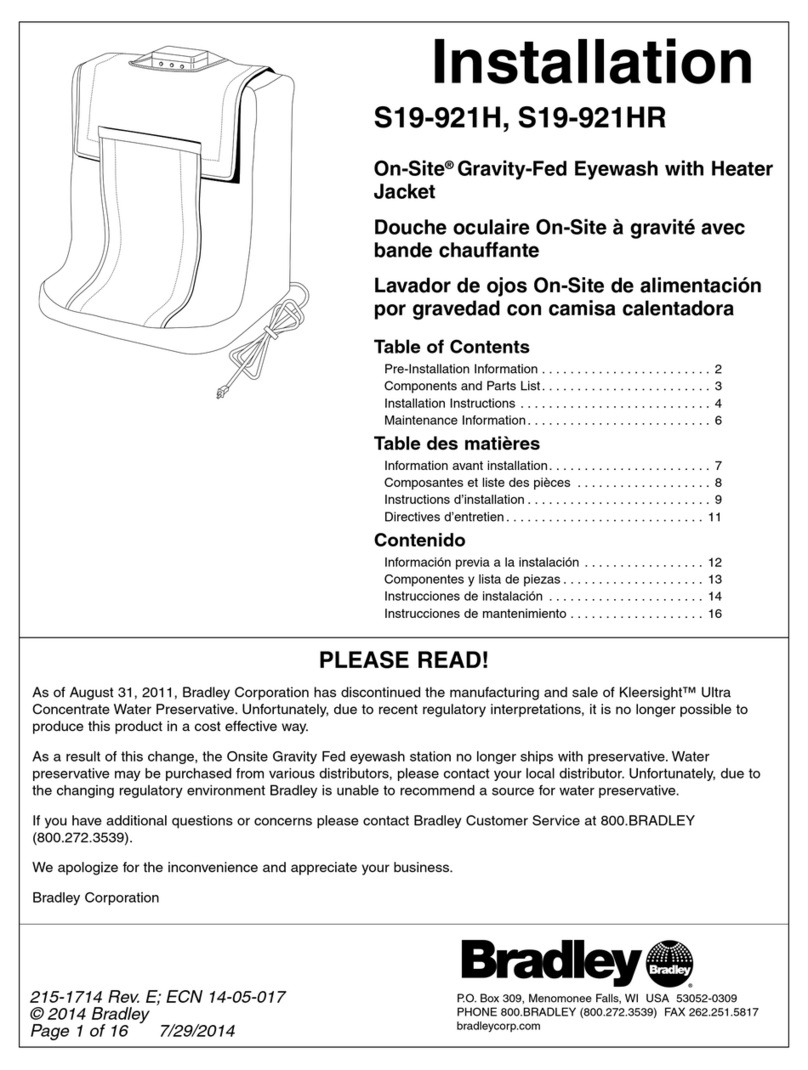
Bradley
Bradley S19-921H Installation
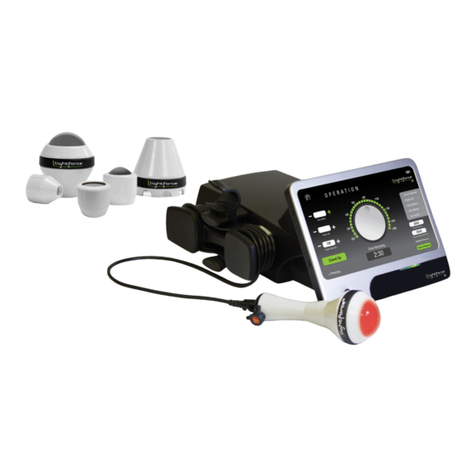
LiteCure Medical
LiteCure Medical LightForce FX user manual
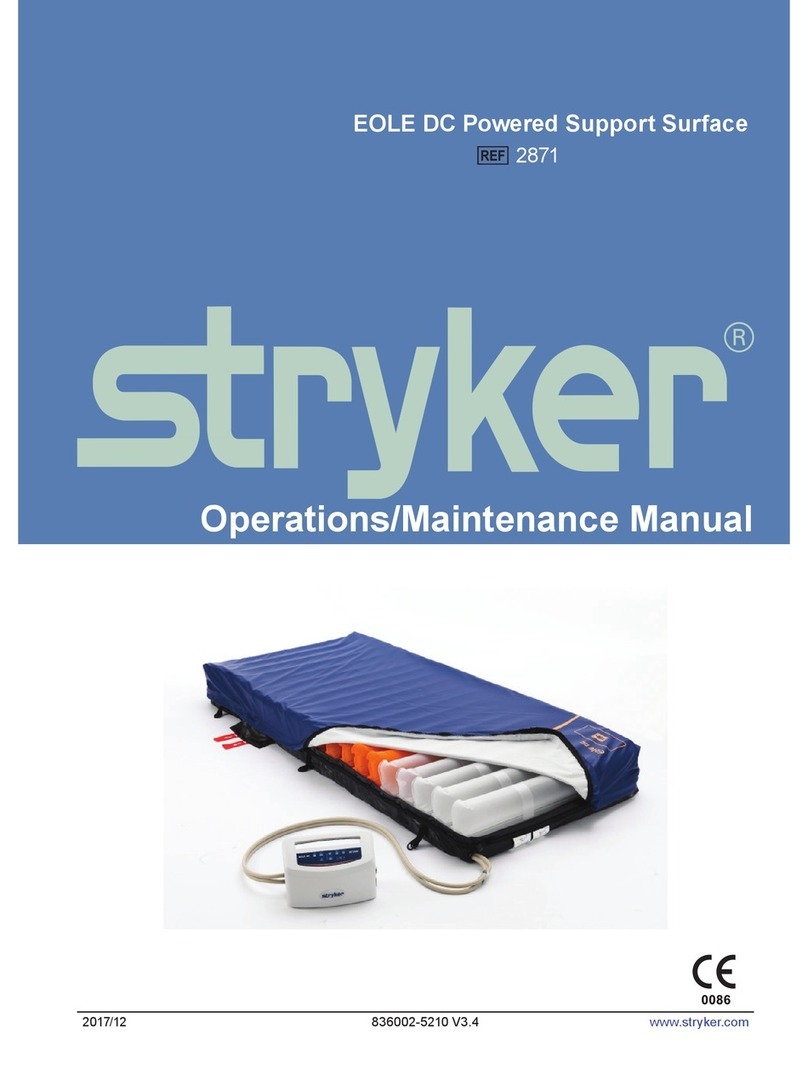
Stryker
Stryker EOLE DC 32" Operation and maintenance manual
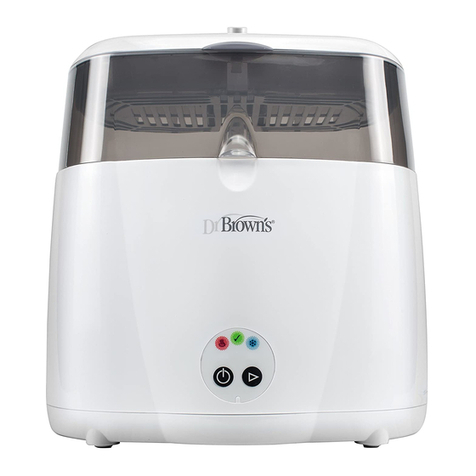
DrBrowns
DrBrowns Deluxe Bottle Sterilizer User instructions
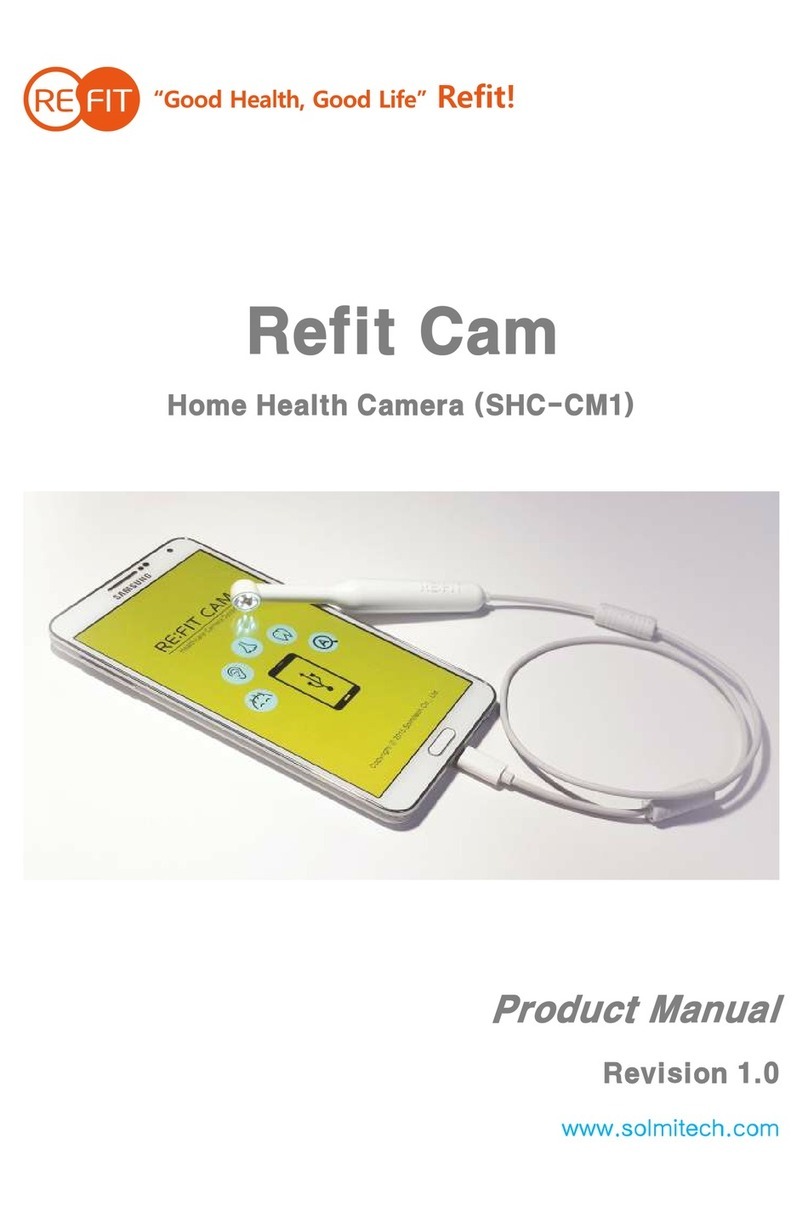
Refit
Refit SHC-CM1 product manual

Medical Alarm
Medical Alarm MediPendant MED01 owner's manual


